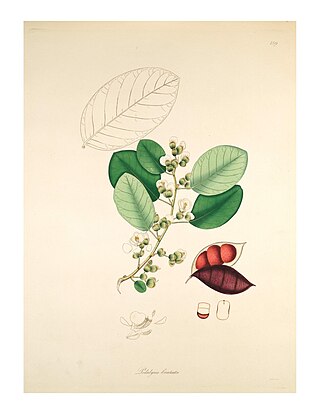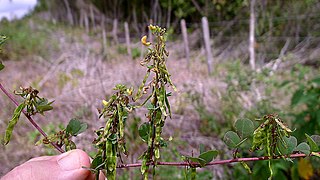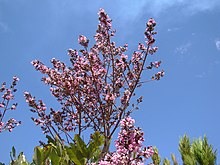
Camoensia is a genus of 2 species of lianas in the family Fabaceae, subfamily Faboideae, native to the Gulf of Guinea, Africa. C. scandens is cultivated as an ornamental plant; it has one of the largest leguminous flowers, up to 20 cm across. The genus has classically been assigned to the tribe Sophoreae, but was recently assigned to its own monophyletic tribe, Camoensieae, on the basis of molecular phylogenetic evidence. Species of Camoensia are known to produce quinolizidine alkaloids, consistent with their placement in the genistoid clade.

Baphia is a small genus of legumes that bear simple leaves. Baphia is from the Greek word βάπτω, referring to a red dye that is extracted from the heartwood of tropical species. The genus is restricted to the African tropics. Baphia was traditionally assigned to the tribe Sophoreae; however, recent molecular phylogenetic analyses reassigned Baphia to the tribe Baphieae.
Ormocarpum is a genus of flowering plants in the legume family, Fabaceae. It includes 17 species native to tropical and southern Africa and parts of India, Indochina, Malesia, Papuasia, and the South Pacific. The genus was recently assigned to the informal monophyletic Dalbergia clade of the Dalbergieae.

Amphimas is a small genus of flowering plants in the family Fabaceae. It belongs to the subfamily Faboideae. It is a west African tree used for medicine and for wood. Amphimas was traditionally assigned to the tribe Sophoreae; however, recent molecular phylogenetic analyses reassigned Amphimas into an unspecified position in the Meso-Papilionoideae.
Baphiopsis parviflora is an African species of flowering plants in the legume family, Fabaceae. It is the sole species in genus Baphiopsis. It is a shrub or tree which ranges from Cameroon to Tanzania and Angola.

Brya is a genus of flowering plants in the legume family, Fabaceae. It includes seven species of shrubs or small spreading trees native to Cuba and Hispaniola in the Caribbean. It belongs to the subfamily Faboideae, and was recently assigned to the informal monophyletic Pterocarpus clade of the Dalbergieae. Species include Brya ebenus, a valuable timber tree.

Dalhousiea is a genus of flowering plants in the legume family, Fabaceae. It belongs to the subfamily Faboideae. It includes two species, one native to central Africa, and the other to eastern India, Bangladesh, and Myanmar.
Fissicalyx fendleri is a species of flowering plant in the legume family, Fabaceae. It is a tree native to the tropical Americas, ranging from Panama through Colombia, Venezuela, and Guyana to northern Brazil. It grows in humid lowland forest.

Hymenolobium is a genus of flowering plants in the family Fabaceae. It includes 14 species of trees native to Central America and northern South America, ranging from Honduras to Bolivia and southeastern Brazil. Most species are native to Brazil, the Guianas, and Venezuela, with one extending into Peru, another into Ecuador, and one native to Central America. Trees are typically very tall and emergent in tropical humid lowland rain forest.

Luetzelburgia is a genus of flowering plants in the legume family, Fabaceae. It includes 14 species of trees and shrubs native to Brazil, Bolivia, and Colombia. Typical habitat is seasonally-dry tropical lowland woodland and wooded grassland, and occasionally lowland rain forests. The genus belongs to the subfamily Faboideae. It was traditionally assigned to the tribe Sophoreae, mainly on the basis of flower morphology; recent molecular phylogenetic analyses assigned Luetzelburgia into an informal, monophyletic clade called the "vataireoids". Keys for the different species of Luetzelburgia have been published.

Poiretia is a genus of flowering plants in the family Fabaceae. It includes 12 species of twining, scandent, or erect herbs and shrubs native to the tropical Americas, ranging from southern Mexico to northern Argentina, including Cuba and Hispaniola. Most species are native to eastern Brazil, Paraguay, and northern Argentina; Poiretia punctata ranges further north and west to northern South America, Central America, Mexico, and the Caribbean. Typical habitats include seasonally-dry tropical to subtropical riverine forest, woodland (cerrado), grassland, and shrubland.
Ramorinoa girolae is a species of flowering plant in the legume family, Fabaceae. It is the sole species in genus Ramorinoa. It is a xerophytic tree or shrub native to La Rioja, San Juan, and San Luis Provinces of western Argentina. Unlike most legumes, Ramorinoa girolae does not produce any leaves. It grows in subtropical lowland and lower montane dry forest or shrubland in rocky and sandy areas. It is locally known as chica, and stands of R. girolae are known as chicales. It belongs to the subfamily Faboideae, and was recently assigned to the informal monophyletic Pterocarpus clade within the Dalbergieae. It is the only member of the genus Ramorinoa.
Riedeliella is a genus of flowering plants in the legume family, Fabaceae. It includes three species of scandent shrubs native to Paraguay and eastern and west-central Brazil. They grow in seasonally-dry tropical forest, cerrado, and caatinga. The genus belongs to the subfamily Faboideae, and was recently assigned to the informal monophyletic Pterocarpus clade within the Dalbergieae.

Smithia is a genus of flowering plants in the legume family, Fabaceae. It includes 20 species of herbs or subshrubs native to sub-Saharan Africa, the Indian subcontinent, Indochina, southern China, Japan, Malesia, and northern Australia. The greatest diversity of species is in the Indian subcontinent, with 11 endemic species. Six more are widespread in southern and eastern Asia, and two of these, S. conferta and S. sensitiva, range further to northern Australia. Two species are endemic to sub-Saharan Africa. S. elliotii is native to Madagascar as well as mainland Africa, and S. conferta is also native to Madagascar. Typical habitats include seasonally-dry tropical grassland, wetlands, and streamsides.
Soemmeringia semperflorens is a species of flowering plants in the legume family, Fabaceae. It is the only member of the genus Soemmeringia.
Sweetia fruticosa is a species of flowering plants in the legume family, Fabaceae. It is a tree native to eastern, southern, and west-central Brazil, Bolivia, Paraguay, and northeastern Argentina. It is the only member of the genus Sweetia. It belongs to the subfamily Faboideae. It was traditionally assigned to the tribe Sophoreae, mainly on the basis of flower morphology; recent molecular phylogenetic analyses assigned Sweetia fruticosa into an informal, monophyletic clade called the "vataireoids".
Vataireopsis is a genus of flowering plants in the legume family, Fabaceae. It includes four species of small to emergent trees, native to northern South America, ranging from Colombia, Venezuela, and the Guianas to Bolivia and southern Brazil. They grow in tropical lowland rain forest, in both the Amazon and Atlantic Forest.

The vataireoids are an early-branching monophyletic clade of the flowering plant subfamily Faboideae that are mostly found in northern South America, primarily Brazil.
The Andira clade is a predominantly Neotropical, monophyletic clade of the flowering plant subfamily Faboideae. The members of this clade were formerly included in tribe Dalbergieae, but this placement was questioned due to differences in wood anatomy and fruit, seed, seedling, floral, and vegetative characters. Recent molecular phylogenetic evidence has shown that they belong to a unique evolutionary lineage. It is predicted to have diverged from the other legume lineages in the late Eocene).
Bowringia is a genus of flowering plants in the legume family (Fabaceae), found in tropical Africa and southeastern Asia. It includes four species native to western and central Africa and Madagascar, and to Borneo, Indochina, and southern China.










